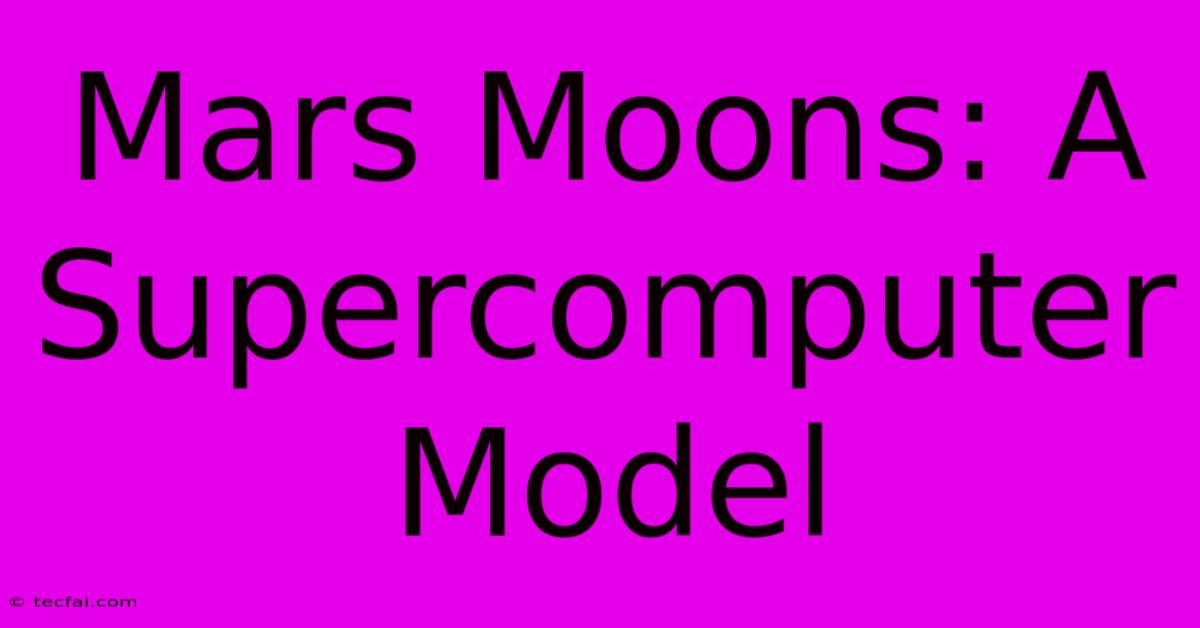Mars Moons: A Supercomputer Model

Discover more detailed and exciting information on our website. Click the link below to start your adventure: Visit Best Website tecfai.com. Don't miss out!
Table of Contents
Mars Moons: Unveiling Secrets with Supercomputer Modeling
Mars, the fourth planet from our Sun, isn't just a rusty, desolate landscape. It boasts two intriguing moons, Phobos and Deimos, which, despite their small size, hold a wealth of mysteries that continue to fascinate scientists. Understanding the formation and evolution of these moons requires sophisticated tools, and supercomputer modeling has emerged as a crucial technique for unraveling their enigmatic origins and predicting their future.
The Limitations of Observation Alone
While telescopes and space missions like the Mars Express have provided invaluable images and data about Phobos and Deimos, direct observation alone presents limitations. The moons' irregular shapes, heavily cratered surfaces, and subtle gravitational interactions with Mars and the Sun make it challenging to deduce their formation processes definitively. This is where powerful supercomputer simulations come into play.
Supercomputers: Powerful Tools for Planetary Science
Supercomputer models leverage advanced algorithms to simulate the complex physical processes involved in the formation and evolution of celestial bodies. By inputting parameters like initial conditions, gravitational forces, and material properties, scientists can create detailed virtual representations of the Martian moon system. These models allow researchers to explore various scenarios and test hypotheses that would be impossible to verify through observation alone.
Unraveling the Mysteries of Phobos and Deimos
Several leading hypotheses exist regarding the origin of Phobos and Deimos. One popular theory suggests they are captured asteroids, gravitationally pulled into Mars' orbit. Supercomputer simulations help to test the viability of this theory by modelling the probability of asteroid capture, considering factors such as their initial velocities, Mars' gravitational field, and the influence of the Sun.
Another compelling hypothesis proposes that Phobos and Deimos formed from debris ejected during a massive impact on Mars early in its history. Supercomputer simulations can model this impact event, tracking the dispersal of debris, the accretion of particles, and the subsequent formation of moons. By comparing the simulated characteristics of the resulting moons with the observed properties of Phobos and Deimos, scientists can assess the plausibility of this impact-origin scenario.
Predicting the Future of Martian Moons
Beyond their origins, supercomputer models also help predict the future evolution of Phobos and Deimos. Phobos, in particular, is experiencing a slow but steady spiral towards Mars. Supercomputer simulations are vital in determining the timescale of this process and identifying the potential consequences, such as the eventual impact of Phobos on Mars or its disintegration into a ring system.
The Role of High-Resolution Modeling
The accuracy of these simulations hinges on the resolution of the models. Higher-resolution models, achievable only with the immense processing power of supercomputers, allow scientists to incorporate finer details such as the internal structure of the moons and the influence of tidal forces. These high-resolution simulations provide a far more realistic representation of the system's dynamics.
Collaboration and Data Integration
The success of supercomputer modeling in planetary science relies heavily on the collaboration of researchers from various disciplines. Experts in astrophysics, geophysics, computer science, and data analysis work together, integrating data from observations with the results of simulations to refine models and improve our understanding of these fascinating celestial bodies.
Conclusion: A Glimpse into the Future
Supercomputer modeling is revolutionizing our understanding of Mars' moons. By enabling scientists to test hypotheses, predict future scenarios, and refine their understanding of the complex dynamics involved, these powerful simulations offer a crucial window into the past, present, and future of Phobos and Deimos. As supercomputer technology continues to advance, we can expect even more detailed and accurate simulations, leading to a deeper understanding of these intriguing Martian companions.

Thank you for visiting our website wich cover about Mars Moons: A Supercomputer Model. We hope the information provided has been useful to you. Feel free to contact us if you have any questions or need further assistance. See you next time and dont miss to bookmark.
Featured Posts
-
Widespread Outlook Teams Outage Microsoft Responds
Nov 26, 2024
-
Drake Vs Umg And Spotify Chart Inflation
Nov 26, 2024
-
Did Asteroid Create Mars Moons
Nov 26, 2024
-
Found D B Coopers Parachute
Nov 26, 2024
-
Great Valleys Tjx Investment
Nov 26, 2024
